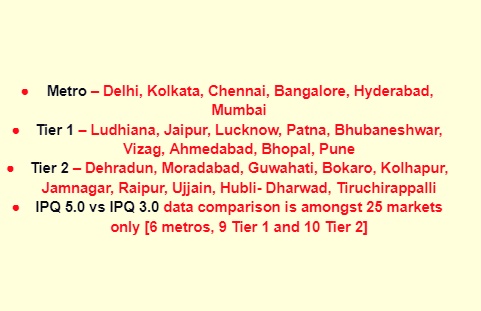
views
Beginning with a ‘Protection Quotient’ of 35 in 2019, India has come a long way. As per the latest edition of the survey by Max Life Insurance, urban India showcased a positive movement, climbing up 8 points on the Protection Quotient to 43 (as per IPQ 5.0) from IPQ 1.0 – signaling steady progress in the country’s overall financial protection levels.
The survey also revealed that the degree to which urban Indians are aware about life insurance products or the ‘Knowledge Index’ moved up from 39 (in IPQ 1.0) in 2019 to 57 and life insurance.
Signalling a shift in priorities and investment patterns, urban India regains focus on investing in long- term milestones.
Saving for children’s education and marriage emerge as top priorities for long-term savings objectives at 60% and 49% respectively, while only 20% setting aside money for medical emergencies. This is in contrast to IPQ 3.0 wherein 31% of respondents focused on saving for health emergencies.
Luxury spends reset to pre-COVID levels with overall allocation towards savings taking a hit.
Budget 2023 Expectations LIVE News Updates: Extension of Affordable Housing Sops on Homebuyers’ Wishlist
India Protection Quotient is an annual analysis report by Max Life Insurance in association with Kantar aimed to understand the pulse of the Indian consumers in the financial protection space.
According to IPQ 5.0, with respite from health-related worries, urban India has begun reprioritising investments in savings plans for life insurance showcasing sustained growth in ownership – up from 24% in IPQ 1.0. to 38% in IPQ 5.0, while term plan adoption rates have grown ~50% in 5 years.
Prashant Tripathy, managing director and CEO, Max Life Insurance, said, ““This year, we see urban India transition to a more secure space, as health anxieties take a backseat. Additionally, while India has begun recognising the real value of term insurance, ownership remains an area of challenge that the life insurance industry will need to work hard to address. While the current findings of study instill confidence in India’s trajectory towards financial independence, a challenging journey lies ahead of us, one that will be marked by the lessons of the past as well as insights that will shape the future of the country’s life insurance sector.”
Financial preparedness of urban Indians
In a positive way, urban India has made huge strides in the Knowledge Index over the past five years. While the survey noted a change from 71% to 73% in life insurance
The survey found the highest progress seen in awareness of life insurance products with more than 45% rise in Knowledge Index since IPQ 1.0.
Ownership of products including term (30%), market-linked (13%) and savings plans (38%).
IPQ 5.0 once again highlights the lead digitally savvy urban Indians command when it comes to Knowledge Index (72), Ownership (79%), as well as security levels (66%).
Digitally savvy urban India’s overall IPQ of 52 is 9 points higher than urban India which is still at 43.
Outlook towards term insurance
‘Real value’ of term insurance reinforced, however, urban India yet to act: term insurance ownership remains stagnant while awareness sees marked improvement.

Urban India warms up to term insurance taking a better interest in awareness about the product. This is reflected in the record-high term insurance awareness level of 64%, a 5%-point increase from IPQ 3.0.
However, term insurance ownership remains to be an area of concern with only 30% adoption rates as opposed to 28% in IPQ 3.0 – denoting a 2% increase.
Fewer Indians perceive insurance as ‘expensive’ as urban India switches its attention to seeking better experience and services; Sum assured, and rider benefits get de-prioritised.
While premium remains a key parameter for buying term plans, IPQ 5.0 findings reveal its diminishing importance in purchase decisions, showcasing a drop from 33% in IPQ 3.0. to 28% in IPQ 5.0. Medical tests and poor service from insurance companies or agents emerge as strong barriers for term insurance adoption.
Alarmingly, sum assured, rider benefits lose importance in the minds of urban Indians.
1 in 2 Indians still feel their term insurance cover is insufficient to safeguard their family’s future.
IPQ 5.0. reveals that almost 50% of urban Indians are still not confident about the adequacy of their term insurance coverage when it comes to protecting their loved ones from life’s uncertainties. However, feeling of insufficiency is observed to be the lowest in 5 years on the back of rising security levels.
India’s tier 1 cities gain ground and show real progress in term insurance ownership—beat metros for the first time in five years.
For the first time in IPQ’s history of five years, tier 1 cities demonstrated the highest term insurance ownership at 38%, an impressive 8%-point increase from IPQ 3.0, outpacing the term ownership rate of metros that stood at 29%. Metro term ownership witnessed a decline of 4%-point from IPQ 3.0 – indicating room for improvement.
Steady progress seen in preference of online channels to purchase term insurance; agent remains the top channel of purchase with 2 out of 3 urban Indians opting for it.
70% urban Indians prefer to purchase term plans through the insurance agent, while 16% prefer to purchase online, highlighting the importance of both ‘DIY’ and agent support for consumers. The survey shows that digital has come a long way to 16% since IPQ 1.0 where only 6% preferred it
Millennials and non millennials
The Protection Quotient of millennials was at par with non-millennials at 43. Additionally, the awareness of life insurance products was equal between the two cohorts, standing at 57%. As non- millennials transition towards crucial life stages, their focus on financial protection solidifies with life insurance ownership rate shooting up from 73% to 77% – overtaking adoption rates of millennials, which stood at 71%.
Men and women
The survey witnessed a marked increase in the Protection Quotient for women, from 36 in IPQ 3.0 to 40 in IPQ 5.0. While life insurance ownership stood at 74% for men and 71% for women, men continue to take the lead over women in term insurance with 31% ownership. However, women are quickly catching up with heightened awareness of term plans – up from 52% in IPQ 3.0. to 58% coupled with increased term insurance ownership – up from 22% in IPQ 3.0. to 27% in IPQ 5.0.
Salaried vs self-employed
Protection Quotient of salaried individuals increased from 41 to 48 in IPQ 5.0, overtaking the self- employed segment which has increased from 39 to 42 owing to the far-reaching impact of the pandemic on the business continuity. Realising the importance of financial protection, the salaried segment responded to the health crisis in recent years placing greater importance on life insurance adoption with ownership of life insurance rates up from 72% in IPQ 3.0 to 81% in the latest edition.
Read all the Latest Business News here



















Comments
0 comment